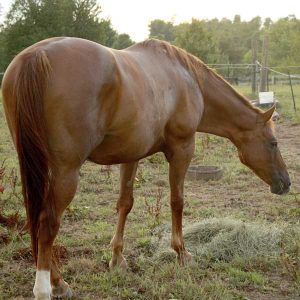
Clarifying Carbohydrates Part III
Is fiber a carbohydrate?
In Clarifying Carbohydrates Part I, we reviewed simple carbohydrates and in Clarifying Carbohydtrates Part II we looked at rapidly fermentable carbohydrates. This Nutritional Minute describes slowly fermentable carbohydrates (fiber) and discusses the concerns associated with all carbohydrates in the equine diet.
Slowly fermentable carbohydrates
Slowly fermentable carbohydrates, or fiber as they are commonly called, are polysaccharides that are made up of numerous monosaccharides, or single sugar units. The slowly fermentable carbohydrates include hemicellulose and cellulose. These carbs have a complex molecular structure that cannot be digested and broken down by gastric acids or enzymes in the foregut. Instead, they are fermented in the hindgut by the resident microbes. Because of the complex structure of these carbohydrates, more time is required for the microbes to completely break them down, hence the name “slowly fermentable carbohydrates.” The byproducts of fermentation are volatile fatty acids that are used to provide energy to the horse.
Where are slowly fermentable carbohydrates found?
Hemicellulose and cellulose are found in the cell walls of individual plant cells and are responsible for the rigid, upright structure of plants. Often these carbohydrates are considered “structural carbohydrates,” referring to their function in the plant. This function is demonstrated by the hard, rigid stems of plants and is also present in leaves.
Pasture and hay are the major source of these carbs. The slowly fermentable carbohydrates, or fiber, content increases as the pasture plants mature. In pasture, maturity can be determined by plant height and presence of a seed head. The taller the pasture, the more mature it is. When the pasture has seed heads, it is at its most mature stage. Hay cut at a later stage of maturity is more fibrous than hay cut in early stages of growth.
Grasses (e.g., orchardgrass) tend to be more fibrous than legumes (e.g., alfalfa), which can be largely attributed to the different physical traits of grasses and legumes. Grasses generally have long slender leaves that require more structural support, whereas legumes have rounder, broader leaves easily supported by the stem.
Carbohydrates review
The simple carbs—sugars and starches—have simple structures that allow for digestion in the foregut by enzymes and gastric acid, which produce readily available glucose for energy. Rapidly fermentable carbs—including resistant starches, fructans, pectins, gums and mucilages—require fermentation in the hindgut, but are quickly fermented. The products of fermentation are lactate and volatile fatty acids. Slowly fermentable carbs—hemicellulose and cellulose—are also fermented in the hindgut, but at a much slower rate. Byproducts of this fermentation are volatile fatty acids, which are also used for energy.
Carbohydrates in your horse’s diet
The most important thing to keep in mind regarding carbs is that the type of carbohydrate you are feeding matters. Diets too low in the slowly fermentable carbohydrates, or fiber, can lead to health problems. Diets too high in simple or rapidly fermentable carbohydrates will also cause health problems. While each type has its place in meeting the energy requirements of your horse, they must each be fed in the appropriate amounts.
Diets high in simple carbohydrates or rapidly fermentable carbohydrates can cause digestive upset leading to colic and laminitis or founder. Horses that eat high-grain diets or pasture with high fructan and starch levels (e.g., spring pasture), are likely consuming large amounts of these types of carbohydrates. When excess amounts of these carbohydrates enter the hindgut they are fermented and lactate is produced. The excess lactate lowers the pH of the gut and disrupts the normal gut environment. Cascading events caused by the drop in pH can lead to colic, laminitis and founder. Limiting the amount of grain in the diet and implementing management practices when pasture is high in these carbohydrates can help reduce simple and rapidly fermentable carbohydrates in your horse’s diet. A veterinarian or equine nutritionist can help you determine what is appropriate for your horse.
Diets too low in the slowly fermentable carbohydrates, or fiber, can lead to health problems as well. Horses receive most of these carbs through their daily forage portion of pasture and/or hay. Insufficient fiber in your horse’s diet may lead to hindgut acidosis (too much acidity), gastric ulcers (due to lack of buffering from saliva production), and/or increased risk of cribbing, wood-chewing and behavioral problems. A general guideline recommended by equine nutritionists is to feed 2% of your horse’s body weight in good quality fiber (slowly fermentable carbohydrates), with half of it being long-stemmed fiber. Talk with your veterinarian or equine nutritionist to determine the appropriate mix and levels of carbohydrates to meet your horse’s individual needs.



1 Comment
Pingback
[…] Clarifying Carbohydrates Part III […]